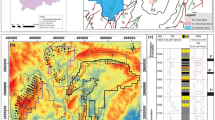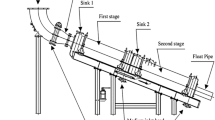Abstract
Dispersing methane to a safer level is crucial for mines safety as methane has been the greatest contributor of explosion hazard in underground coal mines worldwide. Methane dispersion is affected by several geo-mining factors. This study is first of its kind, which makes an attempt to develop a model for predicting methane concentration in underground coal mines based on seven different geo-mining factors using multi-layered artificial neural networks. The main objective is to quantify the relative influences of these factors on methane dispersion in underground coal mines and identify the significant factors through sensitivity analysis. Three different architectures of neural networks were trained using the methane dispersion data generated through computational fluid dynamics simulations conducted at varied geo-mining conditions. Principal component analysis on the input set was done for dimensionality reduction, which reduced the number of variables to seven from eight while maintaining a variance of 99%. All the models performed very well, and the best model yielded mean square error of 0.0304 and R2 of 0.942. The study unveiled some new facts on the relative effects of ventilation type and surface roughness on methane dispersion. It established that air velocity is the most significant and surface roughness of mine galley is the least significant factor affecting methane dispersion in underground coal mines with relative importance of 0.25 and 0.01, respectively. The outcome of this study will be useful in design of mine ventilation system for effective coal mine methane management and enhancing mines safety.










Similar content being viewed by others
References
Coward HF, Jones GW (1952) Limits of flammability of gases and vapours. US Bureau of Mines Information Circular No. 503
Misra GB (1986) Mine environment and ventilation, 1st edn. Oxford University Press, New Delhi
Karacan CO, Ruiz AF, Cote M, Phipps S (2011) Coal mine methane: a review of capture and utilization practices with benefits to mining safety and to greenhouse gas reduction. Int J Coal Geol 86:121–156
Creedy DP, Phillips HR (1997) Methane layering in board and pillar workings. SIMRAC Report, Project No. COL 409:1–116
Mishra DP, Panigrahi DC, Kumar P (2018) Computational investigation on effects of geo-mining parameters on layering and dispersion of methane in underground coal mines: a case study of Moonidih Colliery. J Nat Gas Sci Eng 53:110–124
Bakke P, Leach SJ (1960) Methane roof layers. Safety in mines research establishment. SMRE Res Rep 195:1–62
Bakke P, Leach SJ (1962) Principles of formation and dispersion of methane roof layers and some remedial measures. Min Eng 22(7):645–669
McPherson MJ (1993) Subsurface ventilation and environmental engineering. Chapman & Hall, New York
Raine EJ (1960) Layering of firedamp in longwall working. Trans Inst Min Eng 119:579–597
Fischer D (1973) Characteristics and deflagrations of methane roof layers in mine working. In: 15th International conference of safety in mines research, Karfovy Vary, September, 1973
Kapageridis IK (2002) Artificial neural network technology in mining and environmental applications. In: Proceedings of the 11th international symposium on mine planning and equipment selection (MPES). VSB Technical University of Ostrava, Prague
Mahdevari S, Shahriar K, Sharifzadeh M, Tannant DD (2017) Stability prediction of gate roadways in longwall mining using artificial neural networks. Neural Comput Appl 28:3537–3555
Murthy VMSR, Kumar A, Sinha PK (2018) Prediction of throw in bench blasting using neural networks: an approach. Neural Comput Appl 29(1):143–156
Nguyen H, Bui XN, Bui HB, Mai NL (2018) A comparative study of artificial neural networks in predicting blast induced air-blast overpressure at Deo Nai open-pit coal mine, Vietnam. Neural Comput Appl 1:1. https://doi.org/10.1007/s00521-018-3717-5
Guo H, Nguyen H, Vu DA, Bui XN (2019) Forecasting mining capital cost for open-pit mining projects based on artificial neural network approach. Resources Policy. https://doi.org/10.1016/j.resourpol.2019.101474
Gurney K (1997) An introduction to neural networks. UCL Press Limited, London
Smith KA (1999) Neural networks for combinatorial optimization: a review of more than a decade of research. INFORMS J Comput 11:15–34
Liu DC, Nocedal J (1989) On the limited memory BFGS method for large scale optimization. Math Program 45(1–3):503–528
Jolliffe IT (2002) Principal component analysis, 2nd edn. Springer-Verlag, New York, p 488
Garson DG (1991) Interpreting neural network connection weights. Artif Intell Expert 6(4):46–51
Lek S, Delacoste M, Baran P, Dimopoulos I, Lauga J, Aulagnier S (1996) Application of neural networks to modelling nonlinear relationships in ecology. Ecol Model 90(1):39–52
Olden JD, Jackson DA (2002) Illuminating the “black box”: a randomization approach for understanding variable contributions in artificial neural networks. Ecol Model 154(1):135–150
Olden JD, Joy MK, Death RG (2004) An accurate comparison of methods for quantifying variable importance in artificial neural networks using simulated data. Ecol Model 178(3):389–397
Mishra DP, Kumar P, Panigrahi DC (2016) Dispersion of methane in tailgate of a retreating longwall mine: a computational fluid dynamics study. Environ Earth Sci 75(6):475
Kumar P, Mishra DP, Panigrahi DC, Sahu P (2017) Numerical studies of ventilation effect on methane layering behaviour in underground coal mines. Curr Sci 112(9):1873–1881
Author information
Authors and Affiliations
Corresponding author
Ethics declarations
Conflict of interest
The authors declare that they have no conflict of interest.
Additional information
Publisher's Note
Springer Nature remains neutral with regard to jurisdictional claims in published maps and institutional affiliations.
Rights and permissions
About this article
Cite this article
Mishra, D.P., Panigrahi, D.C., Kumar, P. et al. Assessment of relative impacts of various geo-mining factors on methane dispersion for safety in gassy underground coal mines: an artificial neural networks approach. Neural Comput & Applic 33, 181–190 (2021). https://doi.org/10.1007/s00521-020-04974-9
Received:
Accepted:
Published:
Issue Date:
DOI: https://doi.org/10.1007/s00521-020-04974-9




